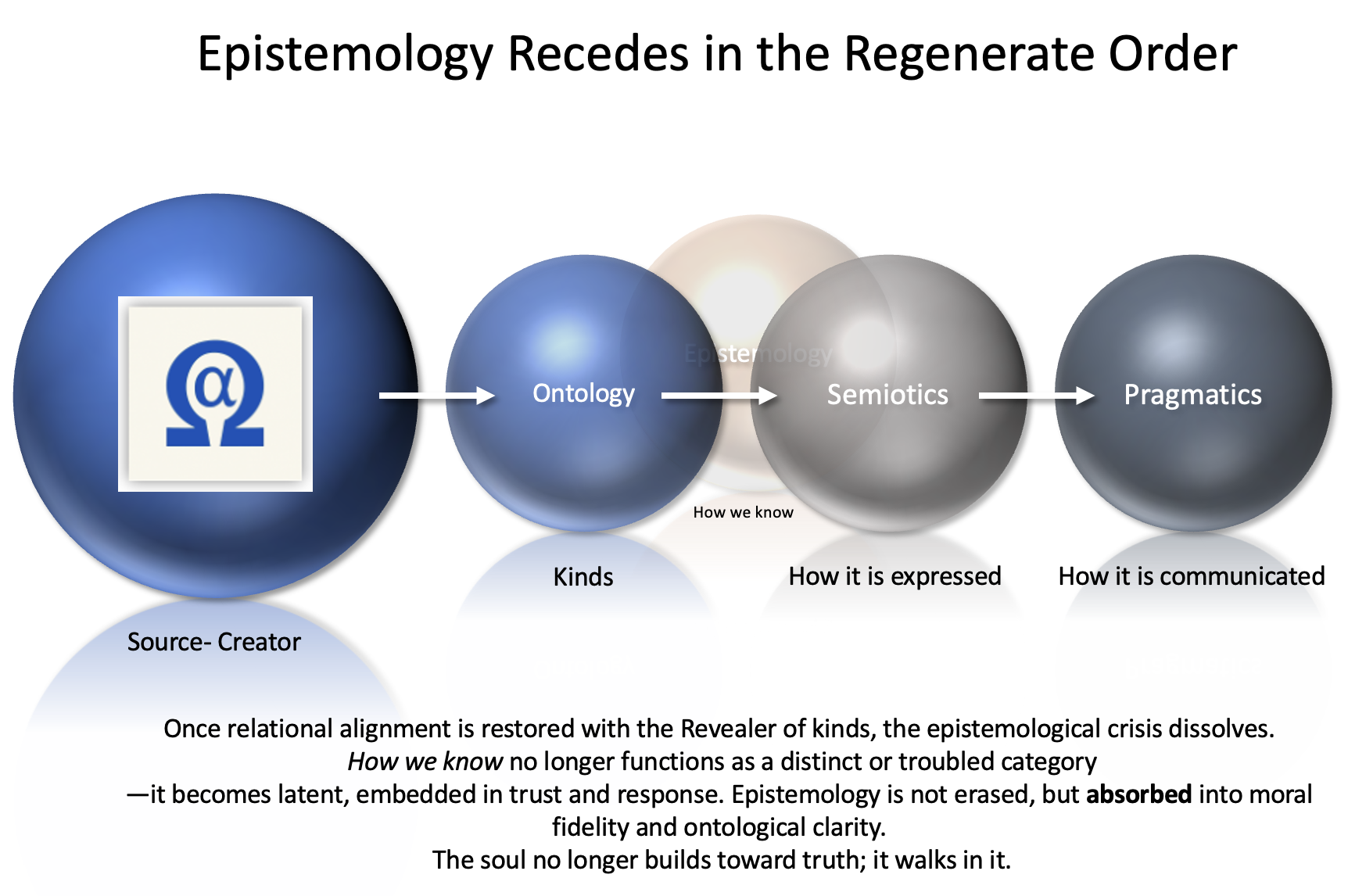This section summarizes the claim that true knowledge is not autonomous abstraction but covenantal participation. Once that relationship is restored, epistemology recedes, not because knowing ceases, but because crisis is over. Truth is not constructed but received. Knowing is not merely intellectual, but relational, moral, and responsive. When that relationship is ruptured, the result is not merely ignorance but ontological dislocation. Regeneration, therefore, is not a change in ideas but a reconstitution of being—restoring the relational alignment necessary for moral clarity and epistemic coherence. From this renewed axis flows the divinely structured moral framework—expressed in the Deontic–Modal unit (DM) and animated by revealed axiology—which makes moral life intelligible, ordered, and accountable. It marks a critical pivot in the overall framework: having established the ontological and moral conditions for knowing and responding rightly, we now move toward the realm of meaning, signs, and symbolic coherence. Semiotics, discourse, and pragmatics do not stand apart from these foundations—they depend upon them. Thus, what follows is not a thematic shift, but a natural progression: from the regeneration of being, to the redemption of meaning.
Knowledge is not a self-contained faculty but a posture toward revealed kinds. Scripture grounds knowing in a reverent alignment: “The fear of the Lord is the beginning of knowledge” (Prov. 1:7). This covenantal awe opens the soul to receive—not manufacture—truth and to obey the One known. The knower must be rightly related to the Knower. Yet in the regenerate state, this posture no longer functions as a separate category; epistemology collapses into covenantal fidelity. The knower becomes one who walks in the light, not one who searches for it.
The Fall was not merely an ethical lapse—it was a rupture of relational ontology. Humanity became epistemically darkened and fragmented. As Paul writes, “they knew God but did not honor Him as God… their thinking became futile” (Rom. 1:21). Knowing, severed from relational trust, devolved into futility.
To know again in truth, one must first be remade. Regeneration is not psychological uplift but relational-ontological realignment. “Unless one is born again, he cannot see the kingdom of God” (John 3:3). This new seeing is epistemic, yet grounded in spiritual rebirth: God grants not only clarity but a will that yields. Once the soul is reborn, the crisis of knowledge ends; epistemology recedes into obedient trust. The regenerate no longer verifies—it obeys.
From this restored posture, moral discernment emerges—not as abstraction, but as covenantal response. Axiology (divine value) orients the heart; the Deontic–Modal unit (DM) structures the conscience (see Essay 5). These are not learned concepts but embedded structures, relationally awakened and animated by grace.
The DM unit convicts (deontology), enables (modality), and discloses fidelity through praxis. Axiology reveals what is good—not inferred from logic or culture, but received from the character and law of God. This moral anatomy is the internal logic of the regenerate soul.
Modern ethical systems retain the form of value, duty, and possibility—but sever them from divine ontology. Axiology becomes preference or utility. Deontology becomes rationalist or procedural. Modality becomes technocratic or emotive. Detached from God, these categories drift into simulation.
Without ontological anchoring, ethics collapses into performance. What looks moral (effigiation) is not fidelity unless it mirrors God’s own instantiation of the good. Only regeneration re-activates the moral structure in truth: simulation mimics duty; regeneration births love-driven obedience.
The regenerate soul is not merely re-oriented; it is re-positioned inside a new ontological order. From that alignment flows both moral coherence and semiotic coherence, for one cannot signify rightly without being rightly aligned. The gift of naming (Gen 2:19; Rev 2:17) is restored to those in covenant.
As we turn to semiotics, keep the axis clear: signs speak truthfully only when rooted in ontological fidelity. Language is never neutral; every utterance discloses rebellion or surrender. Semiotic distortion begins in ontic distortion, so the cure is not rhetorical technique but regenerative realignment. When epistemology is absorbed into moral fidelity, simulation is unmasked: false knowledge springs less from mental error than from ontological mis-alignment. Only those restored to truth can signify truthfully—only fidelity can speak faithfully.
Regeneration realigns the soul vertically with its Revealer and commissions it horizontally toward others. Like Adam’s original mandate to name the creatures (Gen 2:19), the reborn agent must now signify truth—interpreting and articulating meaning amid contested signs—because language itself becomes moral stewardship. Misuse of words is never neutral; each utterance discloses covenantal fidelity or typophoric betrayal. The vertical axis grants moral clarity, the horizontal axis makes it visible. Epistemic “method” therefore follows, rather than produces, alignment: the soul no longer manages truth; truth governs the soul.

